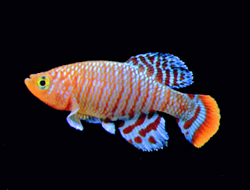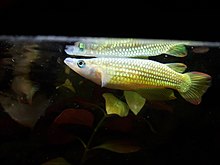
Cyprinodontiformes is an order of ray-finned fish, comprising mostly small, freshwater fish. Many popular aquarium fish, such as killifish and live-bearers, are included. They are closely related to the Atheriniformes and are occasionally included with them. A colloquial term for the order as a whole is toothcarps, though they are not actually close relatives of the true carps – the latter belong to the superorder Ostariophysi, while the toothcarps are Acanthopterygii.

The Rivulidae are a family of killifishes in the order Cyprinodontiformes. They are commonly known as rivulids, South American killifish or New World killifish. The latter names are slightly misleading, however, as they are neither restricted to South America, though most are in fact found there, nor are they the only killifishes from the Americas. Occasionally, they are still referred to as rivulines, a term dating back to when they were considered a subfamily of the Aplocheilidae.

Aplocheilus is a genus of killifish in the family Aplocheilidae. Their native range is in South and Southeast Asia, from India to Vietnam and Malaysia, and from Nepal to Sri Lanka. Several species, especially the striped panchax, A. lineatus, are important aquarium fishes.

Leptolebias is a ray-finned fish genus of the killifish family Rivulidae. Like many of their relatives, they are rather ambiguously known as "pearlfish".

Leptolebias opalescens, also known as the opal pearlfish, annual tropical killifish or opalescent pearlfish, is a species of killifish in the family Aplocheilidae endemic to Brazil. This species was described as Cynolebias opalescens by George S. Myers in 1942 with the type locality given as the base of the Serra do Petrópolis, near Imbarié in the municipality of Duque de Caxias, Rio de Janeiro.
Leptolebias splendens, also known as the splendid pearlfish or annual tropical killifish, is a species of killifish in the family Rivulidae endemic to Brazil, in the vicinity of Rio de Janeiro. This species was described as Cynolebias splendens in 1942 by George S. Myers with the type locality given as water holes or ponds along the foot of the Serra de Petropolis in Rio de Janeiro State. Deforestation and urbanisation led to the species disappearance from the area of its type locality and it was thought to be extinct but it was rediscovered 5 kilometres from the type locality some 70 years after the last known previous record.

Pachypanchax omalonotus, the powder-blue panchax, is a species of Aplocheilid killifish endemic to Madagascar where it is found on the island of Nosy Be and in the Sambirano River basin and adjacent streams on the mainland. Its natural habitat is rivers.

Pachypanchax sakaramyi is a species of Aplocheilid killifish endemic to Madagascar where it is only known from Sakaramy and Antongombato Rivers with reports that it is found in several crater lakes. Its natural habitats are rivers and freshwater lakes. It is threatened by habitat loss and invasive species.

Nothobranchiidae are a family of bony fishes containing roughly 300 species, also known as African rivulines. They are small killifish, usually measuring about 5 centimetres (2.0 in). They are limited to Africa, living in fresh water but being also somewhat salt-tolerant. They are also found in muddy or brackish water. Some species are kept as aquarium pets. They have frilly fins and many are brightly colored. They were formerly included in the family Aplocheilidae ; a return to that broader family has recently been suggested.
The Ceylon killifish is a species of killifish endemic to Sri Lanka. This species grows to a length of 9 cm (3.5 in). Males and females have a black dot at the rear end of the base of the dorsal fin. The females lay 50–150 eggs. The specific name of this fish honours the Inspector-General of Fisheries in India Francis Day (1829-1889), who first reported this fish, although he identified it as Aplocheilus panchax.
Ophthalmolebias ilheusensis is a killifish from the family Rivulidae which is endemic to Brazil where it is only known from river floodplains near Ilhéus in Bahia. Fishbase has this as the only species in the genus Opthamolebias with the other five species which other authorities classify as being within that genus placed in Simpsonichthys. The genus Ophthalmolebias was initially considered a subgenus of Simpsonichthys, but has been elevated to full genus status.
Xenurolebias is a genus of fish in the family Rivulidae. These annual killifish are endemic to temporary pools in the Atlantic forest near the coast in southeast Bahia and Espírito Santo, Brazil.

Simpsonichthys constanciae is a species of killifish from the family Rivulidae that is endemic to Brazil. It is restricted to temporary freshwater habitats in the São João basin in Rio de Janeiro, while all other species in the genus are from Bahia. It is a small killifish that is up to 6 cm (2.4 in) in total length.
Aplocheilus werneri is a species of killifish endemic to Sri Lanka. This species grows to a length of 7 cm (2.8 in). Its natural habitats are small, shallow, slow-flowing, heavily shaded streams and rivulets with a silt or clay substrate. They are largely use as an aquarium fish. The specific name honours the fish importer Andreas Werner who imported this species into Germany for the first time in 1964.

Spectrolebias is a genus of killifish in the family Rivulidae. These annual killifish are endemic to seasonal waters in the Paraguay, Tocantins–Araguaia, Xingu and Mamoré–Grande basins in Bolivia, Brazil and Paraguay. Each species generally has a small distribution and some are seriously threatened by habitat loss; the entire known range of S. reticulatus is in the area flooded by the Belo Monte Dam.

Leptopanchax is a genus of small fish, up to 5 cm (2.0 in) long, in the family Rivulidae. They are found in southeastern Brazil from Paraná to Rio de Janeiro. Depending on the exact species, they inhabit small seasonal channels in the Atlantic rainforest or temporary pools in open habitats. Several Leptopanchax species are very rare and L. sanguineus is possibly extinct.

Ovalentaria is a clade of ray-finned fishes within the Percomorpha, referred to as a subseries. It is made up of a group of fish families which are referred to in Fishes of the World's fifth edition as incertae sedis, as well as the orders Mugiliformes, Cichliformes, and Blenniiformes. It was named by W. L. Smith and T. J. Near in Wainwright et al. (2012) based on a molecular phylogeny, but the authors suggested that the group was united by the presence of demersal eggs that are attached to a substrate. Some authors have used the ordinal name Stiassnyiformes for a clade including Mugiloidei, Plesiopidae, Blenniiformes, Atherinomorpha, and Cichlidae, and this grouping does appear to be monophyletic.
Aplocheilus blockii or the green panchax is a species of fish native to waters around India, Sri Lanka, and Pakistan.

Aplocheiloidei is a suborder of the order Cyprinodontiformes consisting of three families which are commonly known as killifishes.
Pachypanchax patriciae is a species of killifish from the family Aplocheilidae. It is endemic to Madagascar where it occurs in the basins of the Mananjeba, Mahavavy du Nord, Ifasy, Manehoko, and Ampandra rivers in the north west of the island. The specific name of this fish honours the Malagasy conservationist Patricia Yazgi (1946-2006), who ran the charity Friends of Fishes and who supported efforts to document and conserve the freshwater fish fauna of Madagascar. This species appears to feed mainly the adults and nymphs of terrestrial insects and on the larvae of aquatic insects and its most important predators are fish-eating birds and dragonfly nymphs. It may, however, be threatened by introduced alien fishes in some areas.













